Lecture
The method of little men is widely used in TRIZ (Theory of Inventive Problem Solving)
The essence of the method is to present the object as a set (crowd) of little men. This model retains the advantages of empathy (clarity, simplicity) and does not have its inherent drawbacks (the indivisibility of the human body).
The technique of applying the method is reduced to the following operations:
7.1.3. The method of modeling small people MMCH.
The method of modeling by small people (MMCH) was proposed by Heinrich Altshuller.
It has long been noted that the solution of many problems facilitates their representation in the form of models. We have already partially considered such modeling, setting forth the method of empathy (see § 2.3). But such modeling does not always bring success. It is especially difficult to simulate processes using empathy where it is necessary to divide an object into parts, and this is quite explicable. It is not natural for a person to divide himself into parts, and when using empathy in such processes he must present his separation. That is why such problems are quite difficult to solve in this way.
Solving many problems, the famous physicist Maxwell imagined the process under study in the form of little gnomes who can do everything that is necessary. Such gnomes in the literature are called "Maxwell gnomes". A similar method of modeling using a crowd of little men suggested G. Altduller. Any process is modeled with the help of little men, who in our imagination can perform any actions.
We illustrate this method.

Task 7.2. There is a liquid dispenser, made in the form of the device shown in Fig. 7.9. The liquid enters the dispenser bucket. When the prescribed amount of liquid is accumulated, the dispenser will tilt to the left and the liquid will flow out. The left side of the dispenser becomes lighter, the dispenser returns to its original position.
Unfortunately, the dispenser works inaccurately. When tilted to the left, as soon as the liquid begins to drain, the left side of the dispenser becomes lighter, the dispenser returns to its original position, although some of the liquid remains in the bucket. "Underfilling" depends on many factors (the difference between the left and right parts of the dispenser, the viscosity of the liquid, the friction of the axis of the dispenser, etc.), so you can not take more bucket with millet.
It is necessary to eliminate the disadvantage of the dispenser. Do not offer other dispensers: the essence of the task is to improve the existing design. Remember: it is necessary to preserve its inherent simplicity.
Imagine the described construction in the form of a model with the help of little men (Fig. 7.10).
Analysis of this model shows that counterbalance men do not meet the necessary requirements.
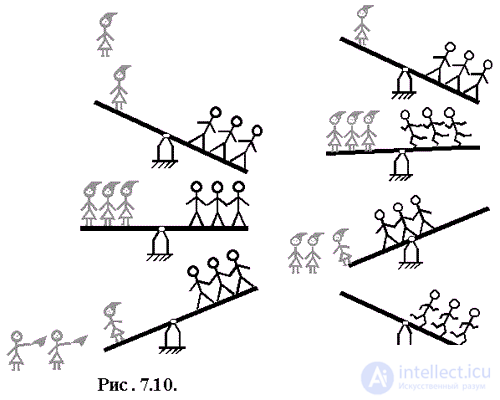
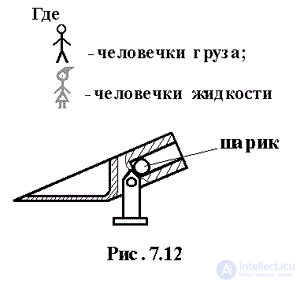
This is where an aggravated (physical) contradiction arises: "The counterweight men must be on the right in order to return the dispenser to its original position, and it must not be on the right, so that the little men of liquid can completely descend."
Such a contradiction can be resolved if the counterbalance men become mobile (Fig. 7.11). Technically, this can be represented, for example, as shown in Fig. 7.12. The dispenser is made in the form of a housing, planted on an axis, on one side of which there is a measuring container, and on the other - channels with a moving ballast, for example a ball 4 .
Let's sort one more task.
Problem 7.3. In hydraulic construction, with the overlapping of the river beds and various types of dumping under water, self-unloading (overturning) barges are used, in particular, the barges shown in fig. 7.13 5 . They consist of two compartments of buoyancy 1 and 2 ("nose" and "feed"), which keep the barge afloat. Between the buoyancy compartments is a cargo hold 3, made in the form of a triangular prism.

The walls of the hold have holes, water always passes into the hold (without this it would be difficult to tip the barge and return it to its original position). Air cavities 4 are located along the body on both sides. The lower part of these cavities is open. When the barge is loaded, it settles, the water draws air into the air cavities. When it is necessary to unload the barge, open the valve 5, the air comes out, the water fills one side of the cavity, the barge overturns. After the load has spilled out, the torque generated by the keel 6 automatically returns the barge to its original position.
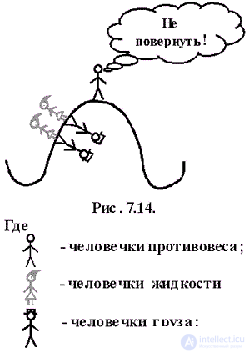
It was decided to use such barges on the construction of the Aswan Dam. Due to specific conditions, it was necessary to create barges with a carrying capacity of 500 tons with low draft, that is, the pain was wide and flat. Constructed a model barge and found that the model does not return to its original position.
To return the barge to its original position, it was necessary to make the keel heavier, but then you have to carry the "dead" cargo all the time. The heavier the keel, the lower the payload of the barge.
How to be?
We depict the described process in the form of a model of little men (Fig. 7.14).
When analyzing the model, we make sure that the counterbalance men cannot cope with the return of the barge to the initial position. The ideal model for this task is: “The counterweight men themselves return the barge to the starting position without increasing their weight. Or the light counterweight returns the barge to the starting position”.
At first glance, such a decision is contrary to the laws of nature. A contradiction arises: "There should be a lot of counterbalance men in order to return the barge to the initial position, and there should be few (or they should not be at all) in order not to carry the 'dead' cargo."
The way out is to increase the mass of counterbalance men at the expense of someone else nearby.
Increasing the mass at the expense of the little men of cargo, we will, of course, turn the barge over, but they will become the counterbalance men, and again we will have to carry the “extra weight”, that is, reduce the overall carrying capacity of the barge. Thus, the cargo people did not help us.
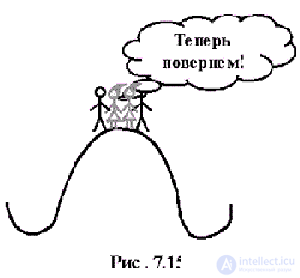
Let's try to use human fluid. If they join a small number of counterbalance men, they will be able to return the barge to the starting position. In water, they will not create additional mass. So this solution is good. It remains only to think about how to hold the little men of fluid around the counterbalance little men (Fig. 7.15).
Technically, this solution is carried out in the form of a hollow keel (Fig. 7.16).

A self-unloading barge is made with a ballast keel tank, having openings in the outer walls, constantly communicating with the outboard space 6 . This may be, for example, a pipe.
Task 7.4 7 . During the Second World War, there was a problem, how to do it so that the enemy would not detect the delivered underwater mine?
Underwater mine in those days was a sphere filled with explosives, and the fuses were made in the form of "horns" (Fig. 7.17). Mina has positive buoyancy. It was attached to the anchor using a cable (minrep), so that it remained at the depth of the draft of the ship.
Mines are caught with the help of special ships - minesweepers. Between two minesweepers there is a cable (trawl).
The cable is deepened with the help of special depthers. The trawl cable comes to the minrep cable (Fig.7.18). When a mine gets into the trawl (the trawl cable moves along the minrep cable), then with a special knife or explosive device, the minrep is cut off. Mina pops up and she is shot.

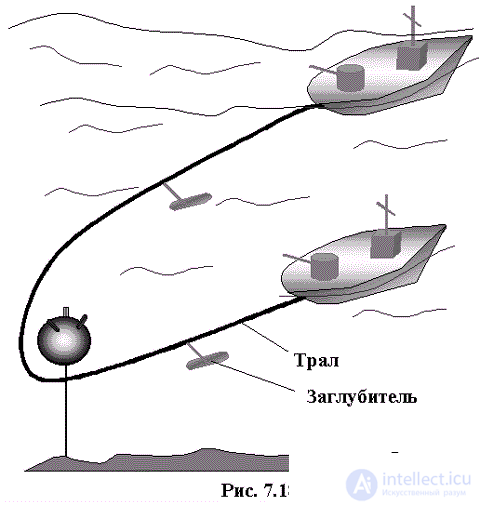
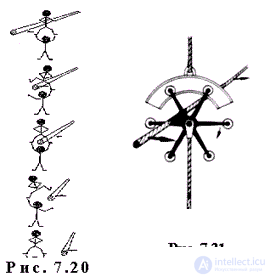
Recall that we need the enemy to not be able to detect and destroy the mines laid by us. Thus, it is necessary that the cable of the trawl "A" pass through the cable of the minipack "B" and would not tear it.
We use the method of MMP. Imagine cable B in the form of successively connected little men, and cable A will remain in the same form (Fig. 7.20) 8 .
Men have two connections between them (two arms and two legs). First they release one link and the cable goes inside. Then they restore this connection again and then break another connection. At this time, the cable comes out on the other side.
One of the possible technical solutions is shown in Fig. 7.21.
Comments
To leave a comment
Idea Creation Methods
Terms: Idea Creation Methods